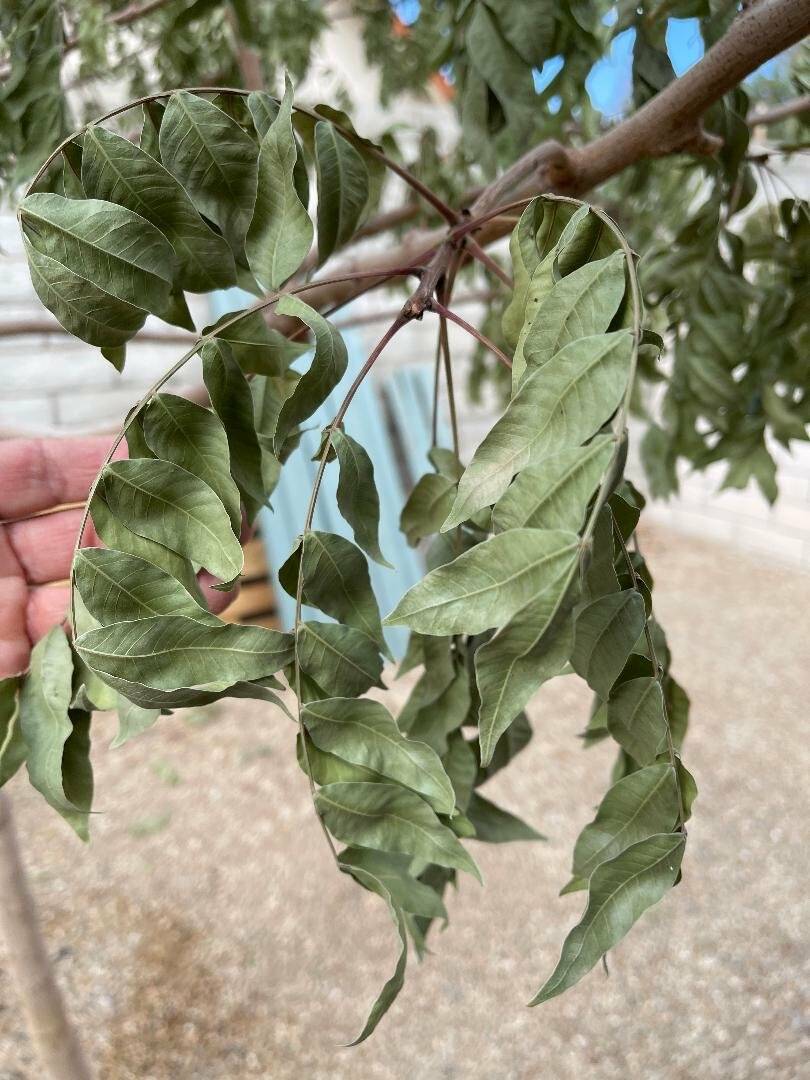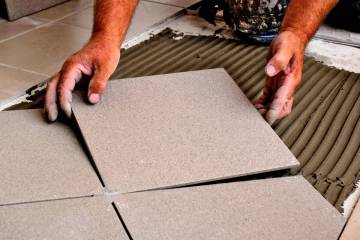Strong wind in spring can damage young leaves
Q: I have two Red Push Chinese pistache trees planted about three years ago and doing well. Recently one was shocked and I’m not sure what happened. This occurred almost overnight. I gave it a few extra gallons and added two drippers to each plant. I don’t use any Roundup or anything like that. Can it be saved?
A: It will take a while, but the tree should be fine. The tree will use its stored energy to put on new leaves and replace the dead ones.
In the future, it’s important to note the weather occurring during that time because we did have some strong winds a few times this summer. Strong winds are particularly damaging in the spring when leaves are new and tender.
Strong winds equal increased water lost by plants. The sudden death of leaves right after strong winds signals a need for water. But that water application is usually just once.
However, frequent watering coupled with poor drainage might also cause this problem. My guess is that leaf death was coupled with the wind. So be careful with applying water to landscapes. It can be the giver of life in the desert, but it also can be the giver of death.
A 3-year-old tree such as Red Push has stored food in its branches that it relies on when pushing new leaves. It takes a bit longer for the tree to respond during the spring and early summer months because it has used up all its spring buds putting on new growth. It’s like a double whammy.
It may take the tree a bit longer to produce new buds and new growth. Tree response to leaf death occurring in late summer and fall is much more rapid since the buds are already formed and new growth happens much faster.
Remember that any of the Chinese pistache trees are mesic in their water use; they can tolerate desert soils but need a little bit of irrigation help. They grow best when surrounded by other plants that require water. As with most mesic trees, they can tolerate lawns when there is decent drainage.
Q: I live in the central Las Vegas Valley and noticed a creep of linear white deposits on the stems of plants in my raised vegetable garden that has recurred in some desert-adapted plants elsewhere in the yard. It first appeared on sunflower stems, then lacinato kale, some basil, tomatoes and their stems, and now on new growth from a vitex tree and turpentine bush. It seems to be spreading, in other words. Can you advise what this is and any way to remedy it?
A: Those white deposits are probably tiny cocoons of tiny insects in the landscape. I reported these on my blog in previous years, calling them “white fuzzies.” I didn’t know what they exactly were either, but I knew that they were insect-related.
A horticulturist in the Phoenix area guessed that they were sharpshooter (insect) pupae, and he may be right. In any regard, these insect pupae were just passing through the landscape where they were incidental and probably not damaging these plants.
Generally speaking, when we see white deposits on many different kinds of plants it’s usually not disease-related but may be related to insects. If these white deposits are insect-related, then look at the plant and note any damage you might see. If there is no damage, then these insects are incidental to your plants.
If you see insect damage to the plants, then it might not be incidental, and it’s best to use your favorite least-toxic insect spray and see if that stops the problem. Soap and water are usually a good first, least toxic spray and readily available. You can always try something more toxic as your second spray if that doesn’t stop the damage.
Q: I need to prevent rabbits from eating plants and flowers in my yard. My HOA doesn’t allow mesh screening, and the commercial preventatives I’ve tried don’t work. I want to plant flowering plants in the ground rather than in very tall containers (tall required as rabbits nibble on anything hanging). Any suggestions are appreciated for the area that gets sun most of the day.
A: If your HOA doesn’t approve of chicken wire, then you can try planting rabbit-resistant flowers and plants. However, if rabbits get hungry enough, they will go after so-called rabbit-resistant plants as well, but these plants are less desirable. If you have any luck, they’ll go after your neighbors’ more desirable plants instead of yours. Your other option is to welcome coyotes into your neighborhood because they love a bunny dinner.
Q: I’ve decided that I wanted to incorporate micro clover into my lawn to help fill in areas and eventually take the grunt of my lawn, if it works out. I was trying to find information on your blog spot but for the life of me could not find the search bar on my phone. Do you have any tips or information on how to go about getting it going and staying alive?
A: I am assuming your lawn is tall fescue or similar cool-season grass and not one of the Bermuda grasses. If you used one of the warm-season types such as Bermuda grass, then most of the stuff I’m telling you would change.
Most people are applying a weed killer to their lawns to get rid of clover rather than encourage it. It just depends on what you want, but growing clover in your lawn decreases the overall visual quality of your lawn. If that doesn’t bother you, then I have no problem giving you direction.
Some people believe that the overall quality of a lawn increases because of the release of nitrogen by the clover, but that’s wrong. Research has shown us that clover, to look its best, requires more nitrogen than it releases. The small amount that it releases is not enough to feed the entire lawn.
Lawns in general require a high amount of nitrogen to look their best. Four to six applications of a high-nitrogen fertilizer are needed, from early spring through early winter, to produce a high-quality lawn.
Fertilizers that best support lawn growth are in 3-1-2 or 4-1-2 ratios. Examples of these ratios would be a 21-7-14 or 20-5-10 fertilizer.
Because lawns consist of grasses, they require a high amount of nitrogen (first number) and lower phosphorus (second number) when fertilized. Growing clover requires a fertilizer high in phosphorus with lower amounts of nitrogen.
Examples of clover fertilizer ratios are 1-2-1 or 1-3-1. Examples of these types of fertilizers are 5-10-5 or 5-15-5. So fertilizing clover requires a different type of fertilizer than grass and lawns to look its best.
In short, if you move ahead with this project expect the clover to decrease the overall visual quality of your lawn. Keep the mowing height of your lawn (if tall fescue) between 2 and 3 inches. When fertilizing, strike a happy balance between the clover’s need for a high-phosphorus fertilizer and the lawn’s need for a high-nitrogen fertilizer.
Q: First the wind destroyed my columnar apple tree leaves. The columnar apple tree was in a pot with a stake to support it. Now my Bing cherry leaves are wilting. I am so upset. The wind is so strong. I put a chair in front of the cherry to keep it from blowing over. I mist it. I am hoping in the fall it will come back.
A: The plants will come back with less windy weather. Wind is very destructive to both fruit trees and vegetables. This is one reason the best food production occurs close to and downwind of a windbreak.
The magic number to remember is 5. Take the height of a windbreak and multiply it times five. This is the distance affected when the height of a windbreak is known. If the windbreak is 10 feet tall, then it’s best to plant within 50 feet downwind of this windbreak.
When we think about windbreaks, we imagine trees and shrubs clustered together in a straight line. Those are the wrong thoughts when we live in the desert. In a desert, first, think of non-water-use windbreaks. Is there something that can be used in place of a line of plants to decrease the wind speed? In a desert environment, those are more appropriate thoughts.
Notice that I used the words “decrease the wind speed” rather than prevent wind or deflect it or stop it. That’s an important distinction when talking about windbreaks.
In windbreaks, the wind should be slowed down rather than prevented. They should have a porosity of about 20 percent: only about 80 percent solid with about 20 percent of it open to air passing through it. Think of a chain-link fence with PVC slats or a wind fabric.
In agricultural areas, wind can dominate from a certain direction. In these areas, a windbreak might be in a straight line. In urban areas, the wind comes from several directions because of deflection by buildings and walls. It’s important to determine the prevailing wind direction for your food production when establishing a windbreak.
Bob Morris is a horticulture expert and professor emeritus at the University of Nevada, Las Vegas. Visit his blog at xtremehorticulture.blogspot.com. Send questions to Extremehort@aol.com.





























